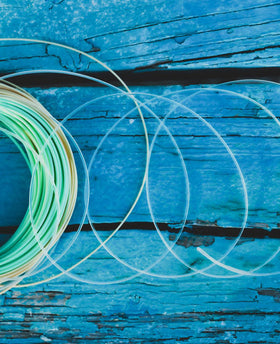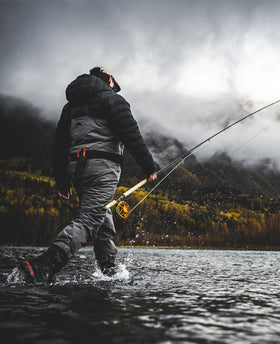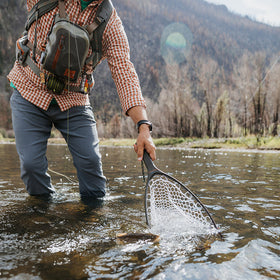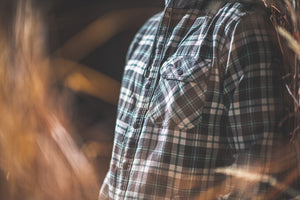
April Setup of the Month: BWO Perfection
April has arrived, and spring pre-runoff fishing has arrived with it. With mayfly hatches at the forefront of this month’s fishing; the Blue Winged Olive is the primary insect on waters throughout the state. April’s Setup of the Month is geared towards fishing this hatch.
Flies: Beatis Lifecycle
The Blue Winged Olive is a subspecies of the Baetis Family, and hatches during the warmest part of the day, usually in the late morning or early afternoon, with any cloudy or rainy weather lengthening, and intensifying the hatch. Its lifecycle consists of three distinct stages; the nymph stage, emerging stage and adult stage, all of which are essential for us to understand in order to predict the feeding habits of trout. We have selected flies to help you imitate this bug at each stage of its lifecycle.

Nymph: Juan’s Tungsten Splitback Shady BWO (#18-24)
The Blue Winged Olive nymph has a slender, tapered body and ranges in color from olive to dark brown. If you see no rising trout, these imitations will be the most important. Take a look under some rocks to determine the size and color of the nymphs in the river you are fishing.

When imitating these nymphs it is important to fish them at a dead drift and at the right depth. Determining depth can be one of the greatest challenges here, and trial and error is required. Usually, the less adult insects you see, the deeper you should make your presentation. The tungsten bead on Juan’s Tungsten Splitback Shady is a great help when you need to get your flies down!
Emerger: Darth Baetis (#18-24)
As Blue Winged Olive nymphs migrate to the surface, they start to shed their exoskeleton, and their wings begin to spread. Once reaching the surface, Blue Winged Olives will drift down river while emerging from their husks. At this stage of the bug’s life it is the most vulnerable, and trout will key into Baetis emergers heavily! Riseforms of fish eating emergers are distinctly different from fish eating on the surface. Look for fins to break the surface of the water instead of a mouth.

Emergers are best fished in the surface film or right beneath the surface. This is best obtained with a dry dropper combination. Fish a dry fly with a Darth Baetis trailed behind it and you’ve got a good combo. Make sure not to put your flies too close or too far apart, as this can cause all sorts of problems with drag. A good distance between a dry fly and emerging pattern is around 24”. To make sure your emerger pattern is riding in the surface column, try putting floatant on your tippet all the way up to your emerger pattern, but allow the fly to become a bit saturated and sink just below the surface.
Adult: Barr’s Vis-a-dun
Once the Blue Winged Olives have fully emerged, they float on the surface of the water drying their wings before they fly to the banks of the river. This is considered the dun stage, and is the stage that trout will rise the most readily. Match your fly size to a dun you find floating down the river. A single dry fly is best in this situation, and look no further than Barr’s Vis-a-dun to get the job done.

When fishing dry flies, getting a drag free drift is of the upmost importance. Most people think of fishing directly upstream when it comes to dry flies, but a downstream approach can be deadly at times. Stand directly upstream of a trout that is rising (far enough away that you dont spook it) and cast directly downstream. After your fly has landed, feed slack by bouncing your rod tip, so that there is no tension as your fly floats towards the fish. This can be a great method when fishing to selective trout, as they will see your fly before they see your leader or fly line.
Rod: Orvis Helios 3
The Orvis Helios 3 line of rods is engineered to reduce the variables and harness the energy behind each cast, leading to impressive accuracy and finesse. The Helios D3 is your option if you are looking for a powerful rod, capable of turning over loops even in the most adverse of conditions. For tricky water, spooky fish, and tiny dries, rely on the finesse-focused Helios 3F, which will consistently present a fly at 60 feet, with a delicate presentation and surprising sensitivity. For extreme specialization check out the Helios 3 Blackout Edition,including a scenario-specific 9'5" 5-weight, an 8'5" 8-weight boat rod, and an 11' 3-weight Euro-nymphing rod. These rods present endless options when it comes to performance, and should fill every niche when fishing April’s Baetis hatch.

Reel: Hatch Iconic 4+
If youre looking for the perfect reel for your 5 weight rod, look no further. The Hatch Iconic is certainly one of the best in the business. With multiple discs and washers in its drag system, start up inertia is completely eliminated, which reduces the overall risk of failure. This also leads to one of the smoothest drags on the market, capable of handling the fiestiest of fish on the lightest of tippet. If you are someone who consistently fishes 5x and 6x, this reel will do an outstanding job at protecting tippet and helping you land the fish of the season!

Line: Elite Rio Gold
The Elite Rio Gold fly line has long head and back taper and is the perfect all around fly line. The line is built with RIO's low-stretch ConnectCore Plus, resulting in exceptional smoothness and durability. We chose this line because of its well-roundedness. With a baetis hatch, you never know if youre going to need a powerful roll cast, or a delicate dry fly presentation. With Elite Rio Gold you get a line that is capable of doing anything, at any time.






Leave a comment